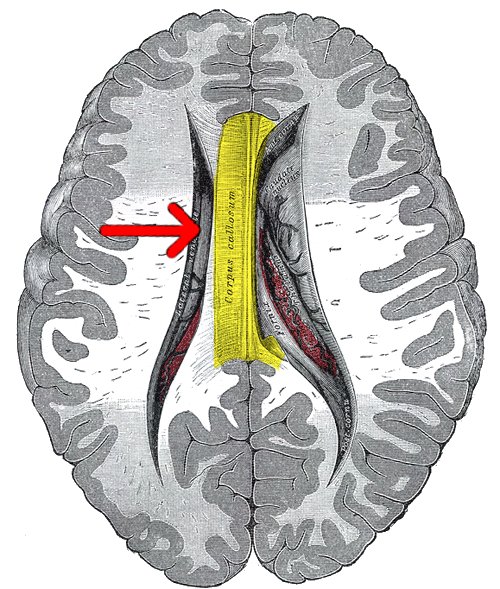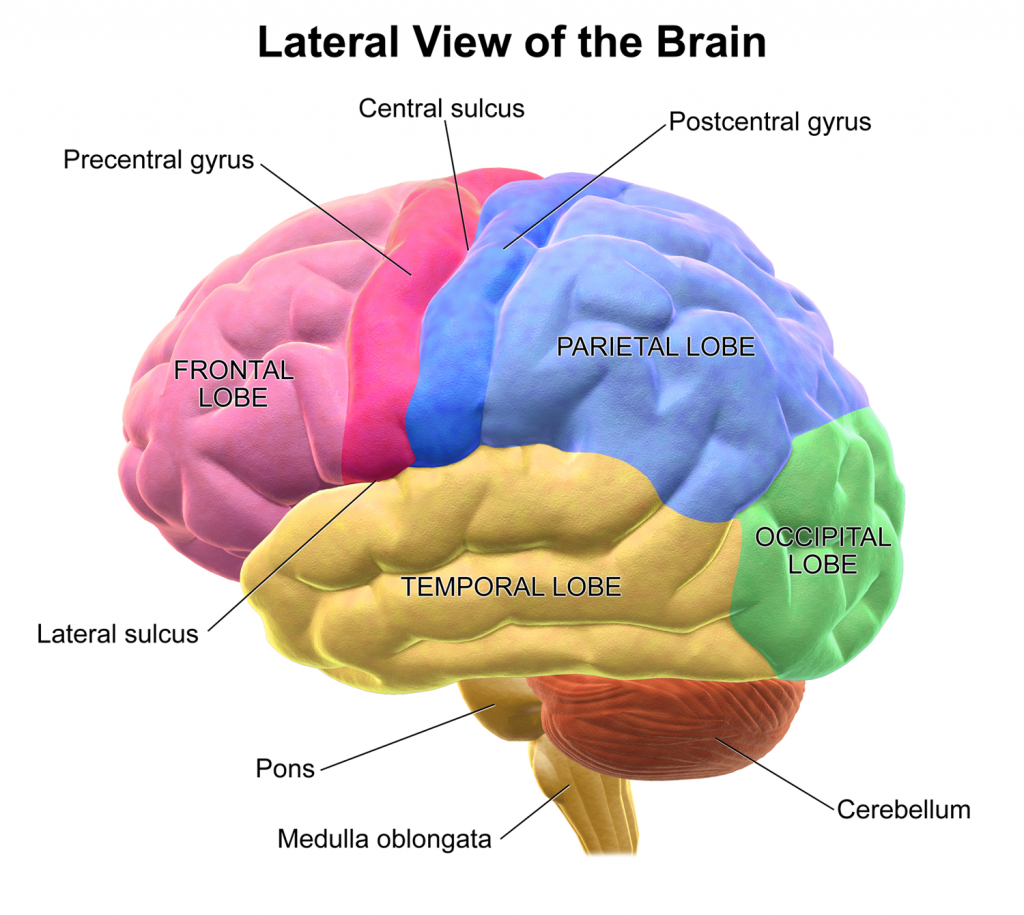
Anatomy
Central Nervous System
The two cerebral hemispheres are connected by which of the following structures:
Answer:
The two cerebral hemispheres are connected by a white matter structure, called the corpus callosum.Cerebral Hemispheres
Anatomy / Central Nervous System
Last Updated: 11th April 2019
The cerebral hemispheres are covered in a thin layer of grey matter called the cerebral cortex which is folded into gyri (elevations) and separated by sulci (depressions). The left and right hemispheres are partially separated by a deep longitudinal fissure (and the falx cerebri of the dura mater which extends into the fissure). The two cerebral hemispheres are connected by a white matter structure, called the corpus callosum which is composed primarily of commissural fibres.

Corpus Callosum. (Image by Henry Vandyke Carter [Public domain], via Wikimedia Commons)
Cerebral Lobes
The cerebral hemispheres fill the area of the skull above the tentorium cerebelli and are subdivided into lobes based on their position relative to the major sulci:
- Frontal lobe – anterior to the central sulcus and superior to the lateral sulcus (extends from the central sulcus to the frontal pole)
- Parietal lobe – posterior to the central sulcus and superior to the lateral sulcus (extends from the central sulcus to the occipital lobe, lies superior to the temporal lobe)
- Temporal lobe – inferior to the lateral sulcus (extends from the temporal pole to the occipital lobe)
- Occipital lobe – posteroinferior to the parieto-occipital sulcus

Lobes of the Brain. (Image by BruceBlaus (Own work) [CC BY 3.0 , via Wikimedia Commons)
Basal Nuclei
The basal nuclei (ganglia) are positioned within the lateral forebrain and function as a supraspinal control centre for skeletal muscle movement. They include the caudate nucleus, putamen and globus pallidum. The basal nuclei are strongly interconnected with the cerebral cortex, thalamus, and brainstem, as well as several other brain areas. The basal nuclei are highlighted green in the image below.
Projection Fibres
The white matter of the cerebral hemispheres basically contains two components; myelinated nerve fibres and neuroglia.
It consists of three types of tracts:
- Commissural fibres which interconnect the corresponding regions of the two cerebral hemispheres (i.e. the corpus callosum and anterior commissure)
- Association fibres which connect the various cortical regions within a cerebral hemisphere allowing cortical coordination
- Projection fibres which connect the cerebral cortex with the lower part of the brain or brainstem and the spinal cord, in both directions
Internal Capsule
Most projection fibres (both ascending and descending) pass through the internal capsule, a layer of white matter which separates the caudate nucleus and the thalamus medially from the lentiform nucleus (putamen and globus pallidus) laterally. This is clinically important as the internal capsule is particularly susceptible to infarction or compression from haemorrhagic intraparenchymal bleeds. Capsular infarct can result in a pure motor stroke with contralateral motor weakness and upper motor neuron signs, or a mixed sensorimotor stroke.

Schematic Illustration of Projection Fibers. (Image by Moeller K, Willmes K and Klein E [CC BY 4.0 , via Wikimedia Commons)
Report A Problem
Is there something wrong with this question? Let us know and we’ll fix it as soon as possible.
Loading Form...
- Biochemistry
- Blood Gases
- Haematology
| Biochemistry | Normal Value |
|---|---|
| Sodium | 135 – 145 mmol/l |
| Potassium | 3.0 – 4.5 mmol/l |
| Urea | 2.5 – 7.5 mmol/l |
| Glucose | 3.5 – 5.0 mmol/l |
| Creatinine | 35 – 135 μmol/l |
| Alanine Aminotransferase (ALT) | 5 – 35 U/l |
| Gamma-glutamyl Transferase (GGT) | < 65 U/l |
| Alkaline Phosphatase (ALP) | 30 – 135 U/l |
| Aspartate Aminotransferase (AST) | < 40 U/l |
| Total Protein | 60 – 80 g/l |
| Albumin | 35 – 50 g/l |
| Globulin | 2.4 – 3.5 g/dl |
| Amylase | < 70 U/l |
| Total Bilirubin | 3 – 17 μmol/l |
| Calcium | 2.1 – 2.5 mmol/l |
| Chloride | 95 – 105 mmol/l |
| Phosphate | 0.8 – 1.4 mmol/l |
| Haematology | Normal Value |
|---|---|
| Haemoglobin | 11.5 – 16.6 g/dl |
| White Blood Cells | 4.0 – 11.0 x 109/l |
| Platelets | 150 – 450 x 109/l |
| MCV | 80 – 96 fl |
| MCHC | 32 – 36 g/dl |
| Neutrophils | 2.0 – 7.5 x 109/l |
| Lymphocytes | 1.5 – 4.0 x 109/l |
| Monocytes | 0.3 – 1.0 x 109/l |
| Eosinophils | 0.1 – 0.5 x 109/l |
| Basophils | < 0.2 x 109/l |
| Reticulocytes | < 2% |
| Haematocrit | 0.35 – 0.49 |
| Red Cell Distribution Width | 11 – 15% |
| Blood Gases | Normal Value |
|---|---|
| pH | 7.35 – 7.45 |
| pO2 | 11 – 14 kPa |
| pCO2 | 4.5 – 6.0 kPa |
| Base Excess | -2 – +2 mmol/l |
| Bicarbonate | 24 – 30 mmol/l |
| Lactate | < 2 mmol/l |

